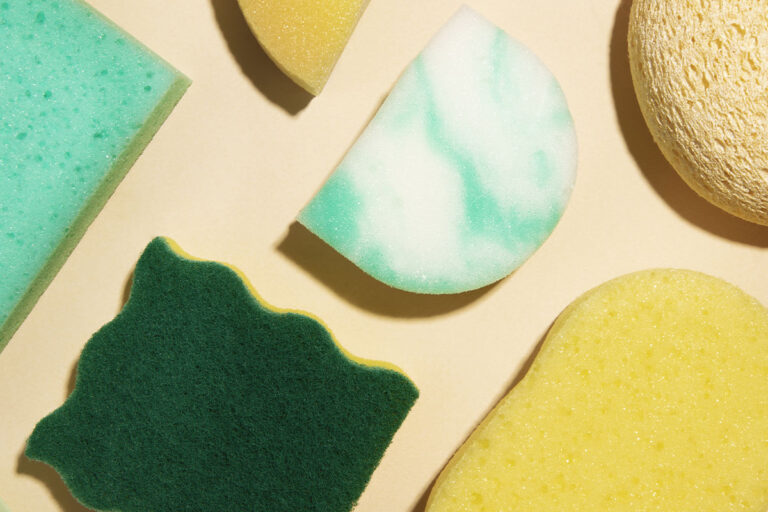Sponges are essential tools in our homes, used daily to clean surfaces, dishes and much more. However, when they become old and unusable, it is important to know how to dispose of them properly. In this article, we will explore where to throw away old sponges, offering some creative ideas for reusing them at home.
Indications for sponge disposal
To correctly determine how to dispose of a sponge, it is important to read the indications on the composition present on the back of the packaging. Be careful not to confuse these instructions with those relating to the disposal of the packaging itself, which may have different requirements.
Where to throw away synthetic sponges
Kitchen and bath sponges are not eternal. Sooner or later, they have to be thrown away. The problem is that we don’t always know where to dispose of them correctly. The old synthetic sponges must be thrown away in the unsorted waste bin. This applies to all synthetic sponges, regardless of their use, unless otherwise specified on the packaging.
Synthetic sponges are usually made of different materials, including plastic materials, which cannot be recycled or disposed of otherwise.
How to dispose of natural fiber sponges
There are also sponges made from natural fibers, which are a more eco-friendly choice since biodegradable and compostable. MartiniSPA produces various sponges in natural fibers, such as sisal cellulose, loofah and viscose extracted from bamboo. These sponges can be disposed of in organic waste or home compost, as long as they are not impregnated with detergents. It is important to wash them thoroughly before disposing of them.
For example, the collection Eco Massage of MartiniSPA is made up entirely of materials of plant origin, coming from renewable sources such as cotton, loofah, sisal, cellulose and wood. Also the packaging is ecological, made of 100% recycled cardboard and PLA, a polymer compostable and biodegradable derived from corn, beets or potatoes.
The Massage Natural collection includes a wide range of body care products, using natural materials such as loofah and cotton. The 100% compostable mesh sponge from this line is delicately exfoliating and ideal for a bath full of foam. At the end of the life cycle, the net can be separated from the cotton cord and thrown into the organic waste collection.
To take care of your home while respecting the environment, you can instead opt for our new Mr.Eco collection. Vegetable cellulose sponges, loofah scrubbers, antibacterial copper and stainless steel scourers, bamboo viscose cloths and other eco-sustainable products made with biodegradable, recyclable and plastic-free materials.
Metallic sponges: where to throw them
Metallic sponges, commonly used to remove encrustations and clean difficult surfaces, should not be thrown into organic waste or compost. Although they are made of metal, they cannot be disposed of in metal collection because they are not considered packaging. These sponges must be thrown into the dry waste. In many cases, they can be recycled as metal by bringing them to a separate waste collection center, where they can be disposed of together with other metal waste.
Idee di riutilizzo delle vecchie spugne
Before you throw away the old sponges, you can consider a few creative reuse ideas to prolong their life and reduce waste.
- Cleaning pet toys
Old sponges can be used to clean pet toys. Be sure to wash them thoroughly with warm, soapy water to remove any chemical residue. - Protection for plants
Use old sponges as a drainage layer in plant pots. Place them in the bottom of pots to help retain moisture and improve drainage. - Use them for painting
Old sponges can be cut and used as paint swabs. They are ideal for small DIY projects or for applying paint in tight spaces. - Anti-slip pads
Cut old sponges into small squares and use them as anti-slip pads under furniture or decorative objects to prevent them from slipping. - Cleaning of tools
Worn sponges are perfect for cleaning garden and kitchen tools and other items that can get dirty easily.
Conclusion
Disposing of old sponges correctly is essential to reduce their environmental impact.
Synthetic sponges should be thrown into general waste, while those made of natural fibers such as sisal cellulose, loofah and bamboo viscose can be disposed of in the organic waste. Metal sponges must be disposed of in separate collection centers for metals or in the undifferentiated waste.
Remember to always consult the instructions on the composition of the product on the back of the packaging to determine correct disposal. Also, before throwing them away, consider reusing them at home in creative ways. With these simple practices, we can all contribute to a cleaner and more sustainable environment
